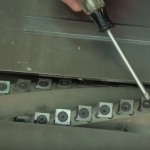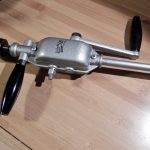We may receive a commission when you use our affiliate links. However, this does not impact our recommendations.
As I mentioned in my “CNC Tooling Basics for Woodworkers” post and the introduction, there are a lot of little details that go into the design of CNC end mills and router bits. Only a few are important for most digital woodworkers, so, this is a streamlined primer focused on the basic details you need to know when choosing router bits and end mills for use on a CNC.
First, a diagram of the parts of a CNC end mill or router bit:

Cutting Diameter is the width of cutting part of the tool
Flutes are the cutting edges along the side of the mill or bit
Length of Cut or “LOC “is the length of the cutting area
Overall Length or “OAL” is the length of the entire mill or bit
Shank is the area of the mill that is clamped into the tool holder or collet.
Shaft Diameter is width of the shaft
Helix Angle is the angle of the cutters from the longitudinal axis
CNC Cutter Design Basics — Flutes
Flutes are the cutting edges you see along the sides of CNC mills and router bits. In the case of the spiral router bits meant for wood cutting, two flutes are most common. CNC mills can have from one to six flutes, though two or four are prevalent.
So what difference does the number of flutes on a cutter make? If you’re cutting wood on a CNC the number of flutes matters quite a bit.
As a woodworker, you might think that more flutes might result in a cleaner cut. After all, when it comes to saw blades, usually more teeth or cutting edges result in a cleaner cut. But, between the fast speeds that CNCs can travel, the higher RPMs that water-cooled spindles achieve and the quantity of wood waste produced, more flutes are usually not the best way to go.
When cutting wood on a CNC we’re creating a massive amount of chips. The more flutes you have means more chips being created per rotation; therefore the CNC has to travel much faster to eject them. There’s even a calculable term for this called chip load (we’ll get into that at a later date). But you need to know that the result of all those chips piling up is the cutter gets hot because it can’t eject chips fast enough – so the material being cut starts to burn and the bit overheats. It’s bad for the cutter and potentially a dangerous situation.
Here’s the rule of thumb: More cutters mean that the CNC has to run faster to eject waste and stay cool. Fewer flutes mean more material can be removed per rotation when running a CNC at slower feed rates. Feed rates on a CNC is a big topic in itself, but let’s take a quick look at what kind of speeds I mean when I say “fast.”
A high-performance four-flute wood cutting bit needs to travel at 1,800-2,000 Inches Per Minute (IPM) to work properly. Only the fastest and most expensive top-of-the-line factory-level machines using 10-20hp spindles can run that fast. At that speed, you stand behind safety shields and just watch the CNC move around in an insane blur. Even three-flute specialized cutters need to run 900-1,200 IPM – still very fast but within the range of the best commercial grade CNCs. Two-flute wood cutters happily run from less than 200 to 600 IPM — which is the real world feed rate range of the kind of machines that a woodworker, smaller professional shops or average cabinet shop CNC are able to achieve. I can tell you from personal experience that it’s still way more than fast enough to do the most frequent task CNCs do for a woodworker: cutting parts.
OK – now for some lessons learned. When I started out I purchased several four-flute cutters thinking they’d give a cleaner cut, but with the exception of a few specialized cutters, they just don’t work for cutting wood on a CNC. Bits overheated. Cuts weren’t clean. Chips were hot and slightly burned. It just never worked. Besides the ones I tried, I’m now left with a number of unused four-flute mills in my collection as a result of learning this lesson first hand. So, I use two-flute spiral cutters almost exclusively for cutting wood and those are what I recommend. I’m not the only one. Notable cutting-tool manufacturers such as Onsrud and Vortex recommend two-flute mills for woodworking on the kind of CNCs we typically use, too.
Other CNC End Mill Design Details
Helix Angles You don’t need to worry about this too much except to keep in mind that the best range for cutting wood are considered low helix when compared to metal cutting bits: 22° to less than 30°. There are exceptions at both ends, but for the most part, cutters intended for our use are within that range.
What about single-flute cutters? They’re rarely appropriate for cutting wood on a CNC (there are a few exceptions for specialized finishing bits). But for use on aluminum or hard plastics, single flutes are most common. Special single-flute cutter designs called O-flutes are the tool of choice in those cases.
So in short, the only realistic choice for cutting wood on a CNC is to use cutters with fewer flutes. And that almost always that means two.
Too see the entire series on CNC Tooling Basics, click here.
Here are some supplies and tools we find essential in our everyday work around the shop. We may receive a commission from sales referred by our links; however, we have carefully selected these products for their usefulness and quality.










Great to see CNC articles here Tim, can we expect some Personal/ Hobby machine reviews?